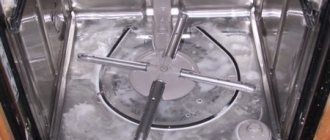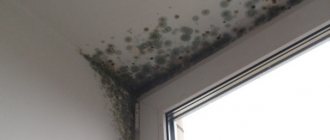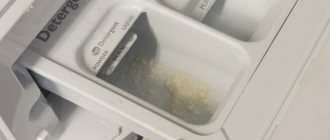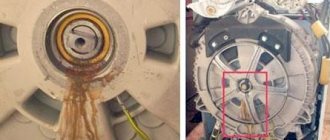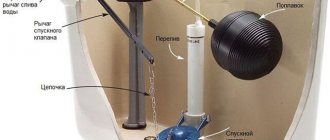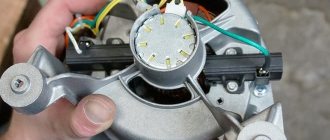The water that goes into the dishwasher is used many times. After fan spraying, it undergoes filtration and again enters the recirculation engine. At the end of the cycle, the dirty liquid is finally discharged into the sewer. Sometimes breakdowns occur in which the dishwasher does not remove the waste solution. Then, to fix the problem, they diagnose the machine and find the cause.
How a dishwasher works
In many ways, the design of a dishwasher is similar to the operating principle of a washing machine. The single outlet valve allows liquid to enter the dishwasher and fill the tank to the specified level. Then, using a recirculation pump, it is supplied to the rocker arms. After this, the water pressure gives the rocker arms a rotational movement. Thanks to fan spraying, food remains are washed away.
Should there be water left?
Many people become concerned when their dishwasher leaves water at the bottom. There is really no problem here. The liquid is needed to moisturize the rubber parts inside the mechanism. Rubber seals retain their functionality longer against remaining moisture on the bottom, walls, salt compartment or filter.
Another reason for water standing in the dishwasher is a clogged filter. Even large slots cannot save you from this. To troubleshoot the problem, perform the following steps:
- They take out the part.
- Clean it from dirt.
- Rinse off any remaining dirt with a strong jet.
- Pump out the liquid.
All these steps are easy to do yourself. First, remove the front panel at the bottom of the device. Then they work from the bottom of the dishwasher to open access to the drain pump. It is held on by several screws. Then to remove the part they are simply unscrewed.
Sometimes the fact that there is water in the dishwasher is not a sign of a problem. In this case, the liquid should not be cloudy and its level should not exceed 1 cm. Otherwise, the operation of the drainage system of the device will be disrupted. In this case, the machine does not drain the waste liquid.
Dishwasher does not drain water: reasons
The first common cause is clogged filters. To an inexperienced viewer it seems that the gaps are large. In practice, after the coarse step there is a fine one; it is almost impossible for a person without a magnifying glass to see the size of the holes. Unless into the light. It will be more difficult for the owners of Whirlpool, if there are any in Russia. To remove the filter, you will have to disassemble the impeller subsystem by first removing the lower one and undocking the plastic segment of the water supply. Afterwards you can, at the very least, remove the sump cover with filters.
Clean the filter, rinse with running water, try pumping out. You can manually fill the working chamber with a couple of glasses. After turning on, the dishwasher, detecting the presence of water, will try to get rid of it by turning on the pump. The convenience of the equipment, unlike washing equipment, is obvious: the drainage pump is relatively easy to dismantle. It is recommended to remove the lower bezel. You will find access to the pump from the bottom. Perform the necessary operations.
The sump pump is held in place by a pair of screws, in Whirlpool's case it will be Torx. The mechanism resembles what you saw in a washing machine:
- The asynchronous motor is equipped with a pair of coils at the base.
- The rotor is magnetic with several poles.
- The impeller crosses, due to centrifugal acceleration, pushes water to the periphery with a snail.
- Power supply 230 volts.
Bottom impeller
Check if the pump impeller is spinning. It rotates tightly, immediately a quarter (half) turn, jerkily (synchronous motor). The coils ring, the nominal value is about 200 Ohms. It is easy to check the mechanism by connecting to a 230 volt network. We remind you again: the starting mode is individual, indicated in more detail by the unit body. When dismantling the pump, water will probably pour down. There are no emergency measures in dishwashers, the volume is small, inferior to washing machines (devoid of Aquastop).
In most cases, you wind the pump coils by hand. The cost of a new part starts from 300 rubles. Decide for yourself whether it is worth wasting time. The rotor can be adapted for homemade designs in the future.
What to do if water remains in your Bosch car
Household appliances made in Germany are of high quality and reliable. Therefore, the reason for the appearance of water at the bottom of the dishwasher is not mechanical failures, but organizational problems. This could be a clogged hose in the drainage system or a pinched drain. Then perform standard actions to eliminate the malfunction.
Sometimes water is not drained due to a breakdown of the control unit. If the pump triac fails, the corresponding command is not issued. Typically, the element breaks when moisture gets on the contacts or after a sudden change in voltage in the network.
To remove the electronic unit, perform the following steps:
- The bunker is opened.
- From the inside, unscrew the screws located along the contour of the block.
- Cover the sash and remove the outer panel.
- The wiring is disconnected from the block.
- Inspect the device to look for damage.
After the inspection, you need to decide whether the electronic device needs repair. Typically, repairing the control unit is not much cheaper than buying a new dishwasher.
What to do if there is water in the dishwasher
Over time, dishwasher owners find that after the washing program ends, dirty water does not drain out. Modern devices notify about such a problem with a sound signal or an error light that lights up. There are several reasons for water stagnation. The following can be eliminated on your own:
- clogged drain system or filters;
- incorrect connection of the drain hose;
- contamination of areas of the drainage system.
Other reasons require specialist intervention:
- accumulation of debris in the drain pump;
- software module malfunction;
- drain pump failure.
A small amount of water always remains at the bottom. If it is clean and does not exceed 1 cm, this is specifically provided for by the design so that the rubber seals do not dry out over time.
Constant drainage of accumulated water
In this case, check the leakage microswitch. This device is located under the tray. To check it, ring the winding at different positions of the float pressing the mechanism. As a result, an open or short circuit can be detected. If water is found in the pan, they find out how it got there. The leak is repaired and the pan is drained. Then carry out a test run of the dishwasher.
Sometimes the reason for constant drainage of water is improper installation of the drainage hose. If the tank fill level is above the hose exit point, the machine will continuously drain water. To eliminate the problem, reinstall the drainage according to the instructions.
The dishwasher is equipped with a flow sensor to monitor the level of liquid collected. If it malfunctions, the system records more water than is collected in the tank. When a small amount of water is drained, a signal is given that there is not enough liquid to begin the cycle. Therefore, there is a constant intake and release of water. To resolve this problem, check the serviceability of the flow sensor.
How to check the connection?
If you just bought a dishwasher, much less connected it yourself without involving a qualified technician, and the breakdown occurred immediately, then it is quite possible that the machine was not connected to the sewer correctly. How to connect the dishwasher to the water supply and sewerage system is described by the manufacturer in the instructions. In particular, the most common mistake is that the connection point of the drain hose to the sewer pipe or siphon is too high.
Please note that waste water from the dishwasher is pumped out by a pump with a relatively weak motor. If the connection point of the hose to the sewer is located too high, then the pump will not have enough strength to pump out the water , because according to the laws of physics, it will tend to flow back into the car by gravity. The pump will have to waste power fighting the siphon effect, and this will lead to rapid breakdown of the drain pump.
Important! The quality of pump operation can also be affected by the length of the drain hose; the longer the hose, the greater the load on the pump.
What needs to be done?
- Make sure your dishwasher drain hose is no longer than 2 meters.
- Make sure that the drain hose is not straight, but has some bend.
- Make sure that the height of the hose connection point to the sewer is no more than 40-50 cm from the floor.
If you have completed all three steps and find a discrepancy somewhere, the connection needs to be redone. If everything is in order with the connection, then you need to move on to considering another cause of the malfunction.
How to identify and remove blockages?
As experts rightly note, blockages are the main reason why the outflow of waste water is disrupted. After all, dishwasher users often neglect the basic rules of caring for them, primarily the rules of cleaning. Where can an unfortunate blockage form?
- On a metal mesh, which is located at the bottom of the washing tank near the rocker arm.
- In the coarse filter (a cup with a grid, which is also located at the bottom of the washing tank).
- In the drain pipe.
- In the drain hose.
If you have never cleaned a dishwasher, you should start by cleaning the fine and coarse filters, since this action is the simplest. First we pry up and pull out the metal mesh, and then unscrew the “glass”. We rinse both under running warm water, not forgetting to pre-treat them with a sponge and dishwashing detergent. We put the filters in place.
For your information! To better clean dirt from the filter, you can soak it in warm water with detergent, and then rinse with clean water.
Now let's check the drain hose for blockages. To do this, it must be disconnected from the siphon or sewer pipe. Place a small container to drain the stagnant water, then unscrew the hose and rinse it well with hot water. After all the procedures, it would be a good idea to dry clean the dishwasher using a special certified product.
How to check and repair the pressure switch and drain pump?
The connection is correct, there are no blockages in the dishwasher either, why does the machine still not drain the water normally? Apparently there's something else going on. Experts recommend checking the pressure switch of the dishwasher. The pressure switch determines the amount of water in the dishwasher; if it does not function, the machine will not drain the water completely. Checking and replacing the pressure switch in a dishwasher is a more complicated undertaking associated with disassembling the dishwasher. It is better to delegate this work to a specialist, but you can do it yourself.
When you get to the pressure switch, do not forget to check the functionality of the contacts of its sensor. Often the contacts burn out, and because of this the device stops working. If everything is fine with the water level sensor, let's check the pump. In general, you can determine how the pump works even before disassembling the dishwasher, if you listen to how it drains water and what sounds it makes. A poorly functioning drain pump usually makes a loud noise, and there is practically no sound of water.
Important! Some people, in order to observe how the dishwasher pump works, tilt the working device and look into the tray. Experts do not recommend doing this; it can disrupt the operation of the sensors, which will lead to more serious damage.
To get to the pump, you need to unplug the dishwasher and unhook the hoses. Then you need to place the dishwasher on the back wall, after placing rags under it. In most cases, you will have immediate access to the pump through the bottom without having to remove any walls. We do the following:
- we find the contacts on the pump body;
- take a multimeter, set the smallest value in Ohms;
- we install the probes of the device on the contacts and measure the value, which should be within 1000;
- If the pump's electrics are in order, unscrew it and clean it thoroughly. It happens that a foreign object gets stuck in the pump impeller, slowing down its rotation;
- If the pump is clean but still doesn't work, either replace the pump or call a technician to help sort out the problem.
To summarize, we note why the dishwasher refuses to drain the water normally. There are many reasons, but there is only one consequence - a full tank of dirty water. To cope with the problem, you will have to check all possible causes step by step; this is the only way to find the truth. Happy renovation!
Interesting:
- How to turn on and start the dishwasher
- The water in the dishwasher does not heat up
- Whirlpool dishwasher error codes
- How to use a dishwasher correctly
- Bosch dishwasher repair
- Miele dishwasher errors
Reader comments
- Share your opinion - leave a comment
Preventing drainage problems
To ensure that your dishwasher always works properly, it is important to install it correctly from the beginning. To do this, during installation, be sure to take into account all the requirements specified in the instructions.
If you use your dishwasher regularly, preventively clean the filters every two weeks. Every month, as a preventative measure, the appliance is run without utensils. After each use, clean the rubber seals on the device door from dirt.

